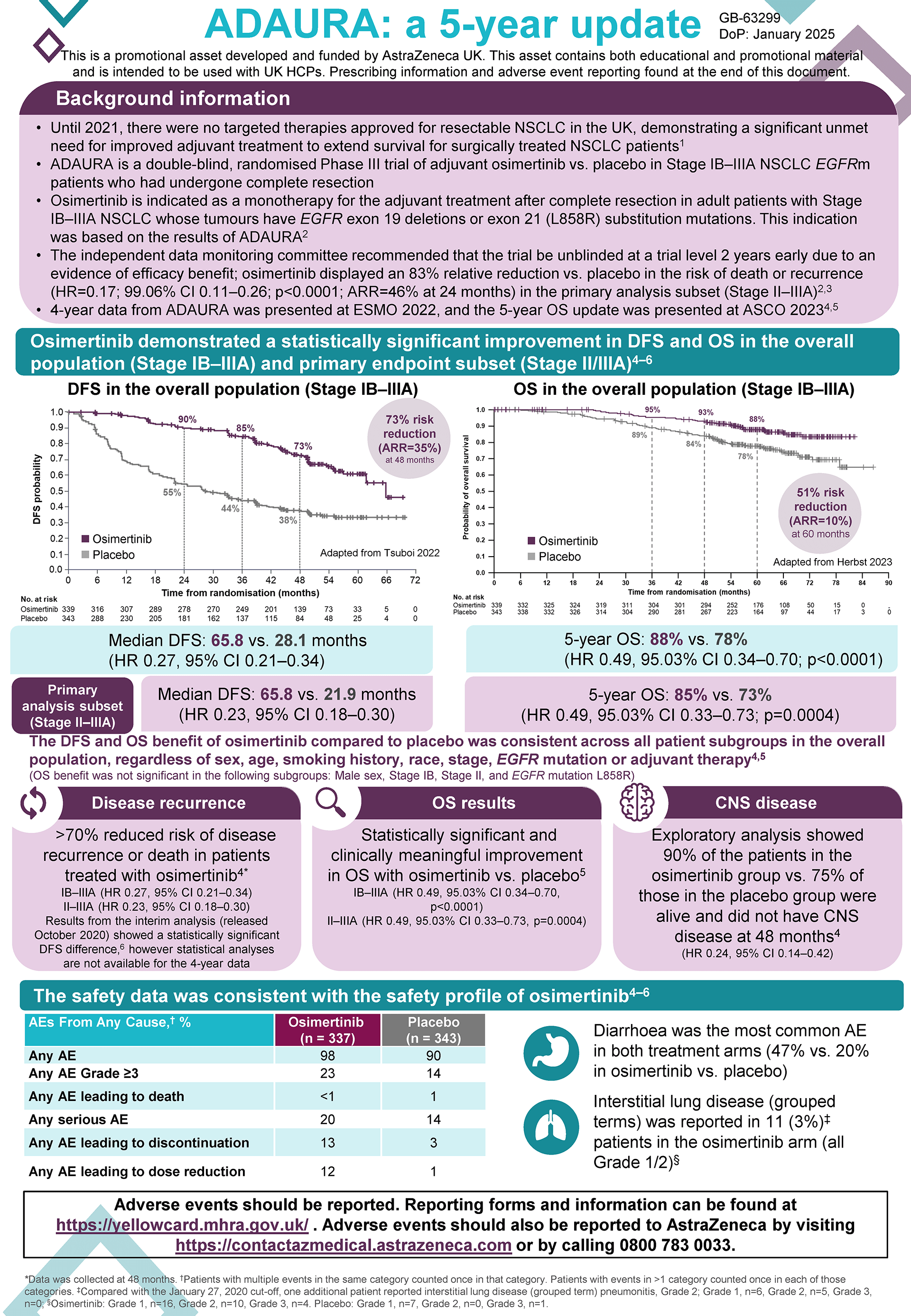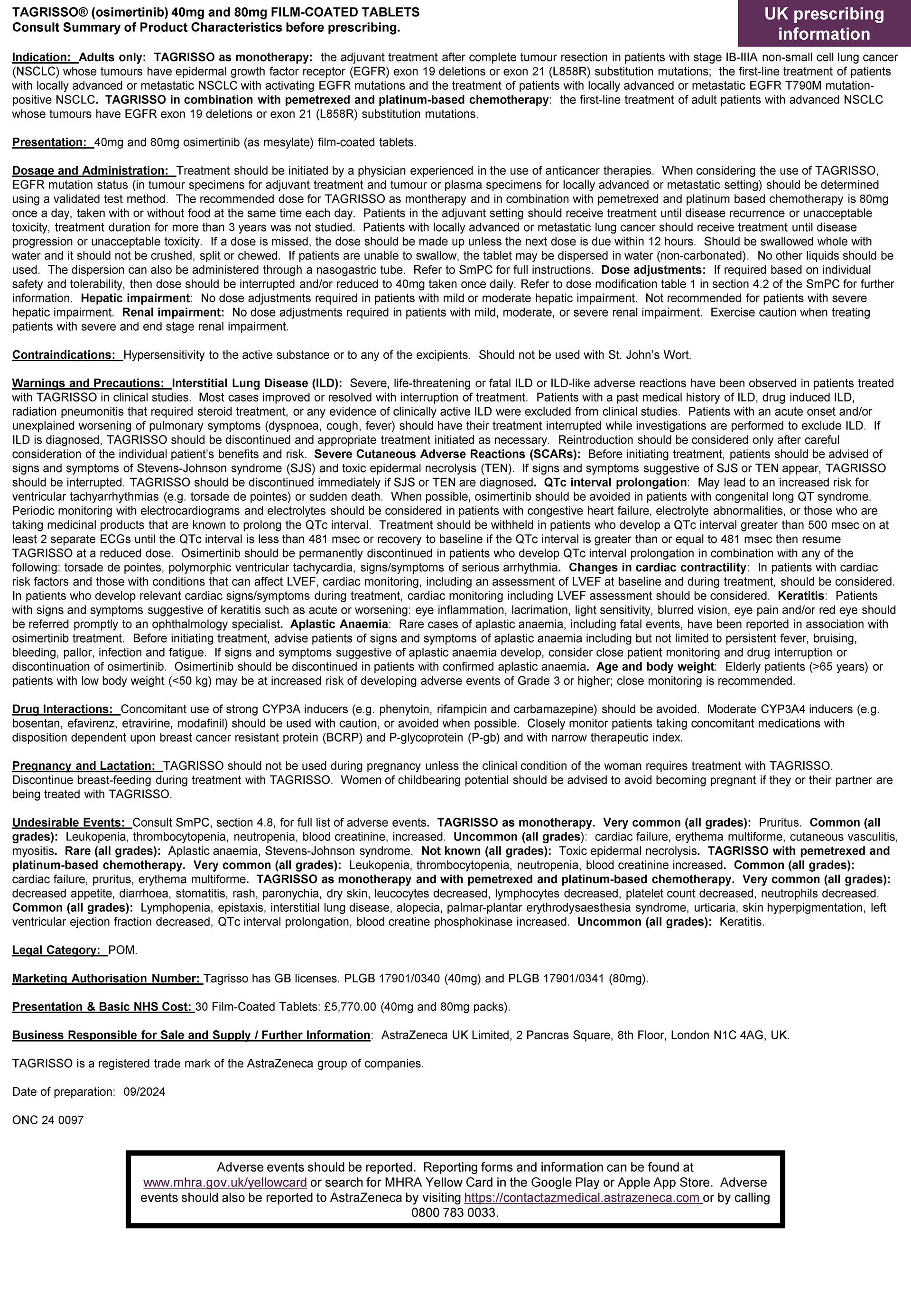
Introduction
The FLAURA2 trial protocol builds on the success of the FLAURA trial, and looks to understand how outcomes can be improved in patients with advanced metastatic epidermal growth factor receptor-mutated (EGFRm) NSCLC (non-small cell lung cancer) patients.
The approval of Tagrisso in combination with pemetrexed and platinum-based chemotherapy as the first-line treatment of adult patients with advanced NSCLC in the United Kingdom, means that patients at risk of progression, like those with central nervous system (CNS) metastases, now have access to this treatment.
Background
The FLAURA2 trial is a randomised, open-label, multi-centre, global Phase III trial in the 1st-line treatment of patients with locally advanced (Stage IIIB-IIIC) or metastatic (Stage IV) EGFRm NSCLC with confirmed EGFR exon 19 deletion or L858R mutation.
Patients were treated with Tagrisso 80mg once daily oral tablets with the addition of chemotherapy (pemetrexed (500mg/m2) plus cisplatin (75mg/m2) or carboplatin (AUC5)) every three weeks (21 day cycle) for four cycles, followed by Tagrisso with pemetrexed maintenance every three weeks. The comparator group was treated with Tagrisso monotherapy 80 mg once daily.
The trial enrolled 557 patients in more than 150 centres across more than 20 countries, including in the UK, US, Europe, South America and Asia. The primary endpoint is progression-free survival (PFS). The trial is ongoing and will continue to assess the secondary endpoint of OS.
Conclusion
Results from the FLAURA2 Phase III trial showed Tagrisso (osimertinib) with the addition of chemotherapy showed a significant improvement in median progression free survival (PFS) in patients with locally advanced or EGFRm non-small cell lung cancer (NSCLC).
Tagrisso with the addition of chemotherapy reduced the risk of disease progression or death by 38% compared to Tagrisso monotherapy, which is the current standard of care (hazard ratio [HR] 0.62; 95% confidence interval [CI] 0.49-0.79; p<0.0001). Median progression-free survival (PFS) by investigator assessment was 25.5 months for patients treated with Tagrisso plus chemotherapy, an 8.8-month improvement versus Tagrisso monotherapy (16.7 months). PFS results from blinded independent central review (BICR) were consistent with the results by investigator assessment, showing 29.4 months median PFS with Tagrisso plus chemotherapy, a 9.5-month improvement over Tagrisso monotherapy (19.9 months) (HR 0.62; 95% CI 0.48-0.80; p=0.0002).
The incidence of grade 3 or higher adverse events from any cause was higher with the combination than with monotherapy — a finding driven by known chemotherapy-related adverse events. The safety profile of osimertinib plus pemetrexed and a platinum-based agent was consistent with the established profiles of the individual agents.
Tagrisso with the addition of chemotherapy also demonstrated a favourable trend toward overall survival (OS) improvement at 2 years of follow up (hazard ratio [HR] 0.75; 95% confidence interval [CI] 0.57-0.97; 41% data maturity), with consistent results across prespecified subgroups, including sex, race, type of EGFR mutation, age at time of diagnosis, smoking history, performance status and CNS metastases status at baseline. The OS data were not statistically significant at this interim analysis and will continue to be assessed as a key secondary endpoint at final analysis.
References
- Planchard et al. N Eng J Med 2023; 389; 1935-1948 DOI: 10.1056/NEJMoa2306434
- Valdiviezo Lama et al. Ann Oncol 2024;9(suppl 3):153. DOI:10.1016/esmoop/esmoop102569



